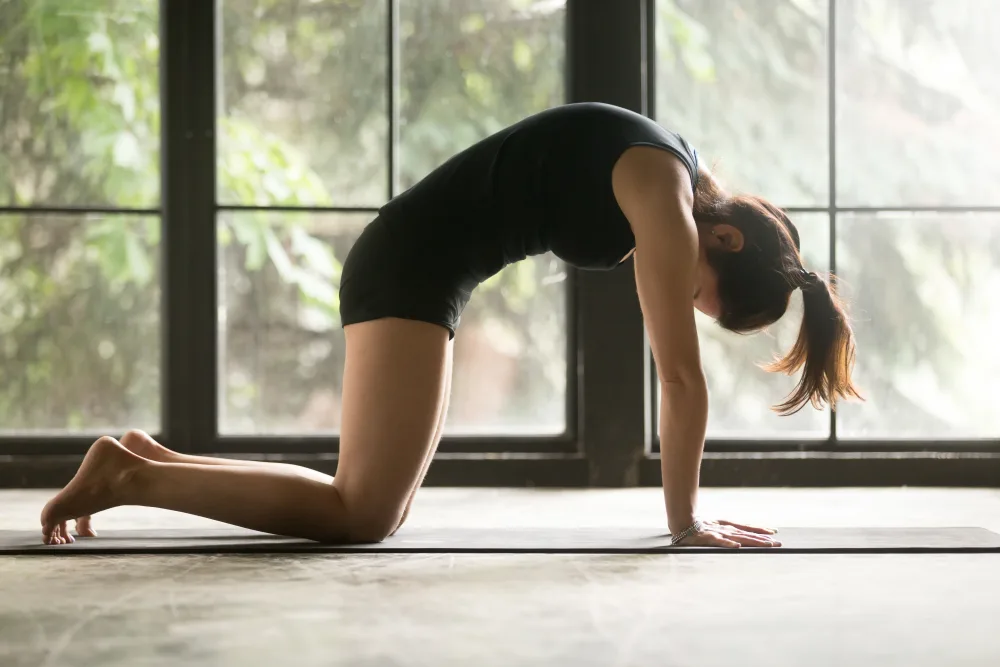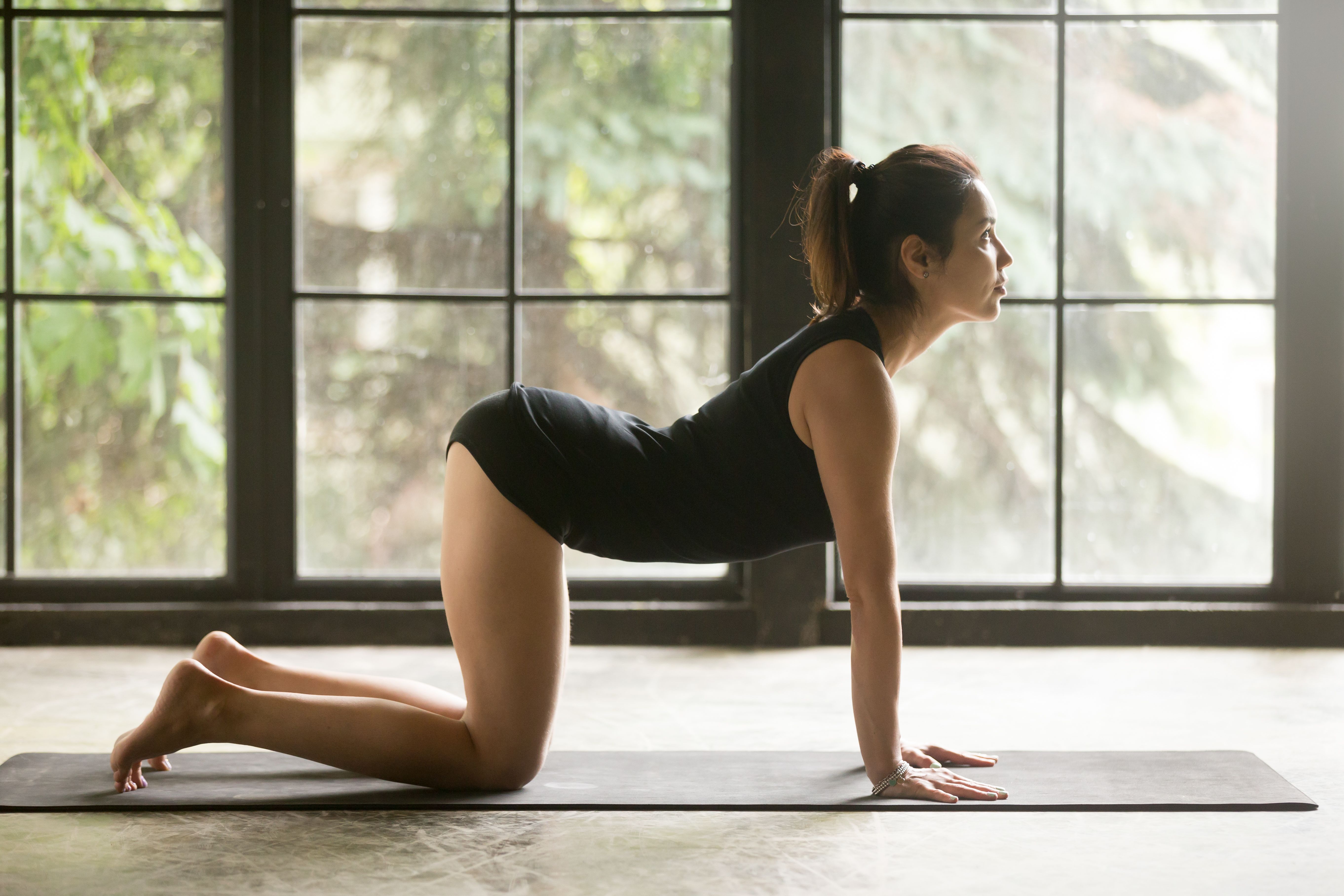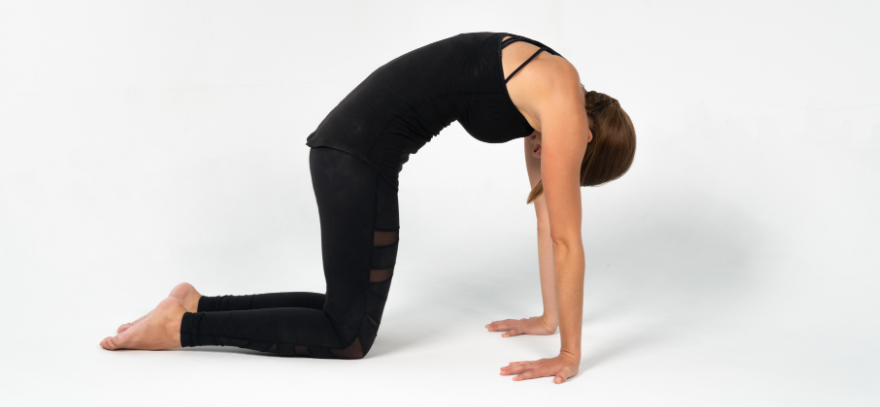What is Bidalasana (Cat Pose)

Bidalasana, also known as Marjariasana or Cat Pose, is a core and spine awakening posture that is usually performed during warm-up routines.
In this pose, the spinal column is rounded and pointed towards the ceiling to resemble a cat rounding its back. Bidalasana provides a gentle massage to the spine, lower back, and abdominal organs.
Usually, the Cat Pose movement is performed alternatively with Cow Pose or Bitilasana in a repeated cycle until the practitioner feels activation of the core and spine muscles.
The repeated cycle is also known as Chakravakasana (Cat-Cow Pose).
Overview and Etymology
Bidalasana is a Sanskrit word that translates to 'Bidal,' which means Cat, and 'Asana,' which means Posture. Its alternate name Marjariasana translates to 'Marjari,' meaning Cat, and 'Asana,' meaning Posture.
A very close cat posture formation was first described as the Tiger Pose, or Vyaghrasana, in the 17th-century Haṭha yoga text Haṭha Ratnāvalī by Srinivasa.
Later, in the 19th-century book Sritattvanidhi, an asana named Marjarottanasana was described as the traditional cat pose. The significant difference was that it was an upside-down cat pose.
Finally, the Bidalasana started gaining popularity in the early 20th century when Niels Bukh's Primary Gymnastics text described the cat pose as a Prone-Kneeling Position.
Sanskrit Name: बिडालासन Pronunciation: bii-DHL-ah-snuh
Pose Type: Dynamic Stretch Also known as: Marjariasana or Cat Pose
Strengthens: Core, Shoulders, and Spine
Stretches: Spine, Tailbone, Traps, Lower Back, and Shoulders
Health Benefits of Bidalasana
- Improves body posture.
- Enhances mobility in the tail bone.
- Relieves lower back tension and pain.
- Strengthens the wrists and shoulders.
- Activates the Throat and Manipura Chakra.
- Strengthens the core, knee joints, and hip joints.
- Increases the flow of Prana (energy) in the body.
- Enhances strength, flexibility, and mobility in the spine.
- Engages core muscles to improve abdominal organ function.
When to Avoid Performing Bidalasana
- Avoid if you have spondylitis.
- Avoid is you have a severe migraine.
- Avoid if you have inflammatory knee arthritis.
- Avoid you have wrist, knees, neck, shoulder, or spinal injuries.
- Avoid after wrist, knees, neck, shoulder, or spinal surgery.
How to do Bidalasana (Cat Pose)
You can perform magic on your vertebrate with Cat pose by following the step-by-step practice below.
Part 1: Preparation for Bidalasana
The cat pose is known as a warm-up posture for all sorts of deep backbends and core balance postures. But if you’re a beginner, you may want to start your practice with the below muscle awakening movements for better blood circulation throughout your body.
1. Wrist Circles - Start drawing circles from your hands and wrist. Keep the movement clockwise at first for 10 to 20 rounds, then repeat the same in a counter-clockwise direction.
This dynamic movement will activate your wrist joints by increasing their range of motion. After this, your hands will be able to bear your body weight for a prolonged duration in the cat stretch.
2. Neck Circles - This warm-up will help release any tension in your neck muscles, plus it will help minimize any tightness in your traps. Simply start with your back and spine in a neutral position and move your neck clockwise.
First, bring your right ear close to your right shoulder, then gently bring your head forward, dropping your chin close to the chest. Finally, roll your head to the left shoulder and get back to neutral. Gently repeat these neck rolls for ten rounds, and then move your neck in a counter-clockwise direction.
3. Ankle Circles - Stand close to a wall and keep your hands by your waist for this dynamic warm-up movement. Start making circles with your ankle joints and toes in a clockwise direction for 10 to 20 rounds. Repeat the same in a counter-clockwise direction as well.
This movement will activate blood circulation in your legs and your ankle joints, increasing your range of motion, which prevents you from injury during the main practice.
Part 2: Step-by-Step Instructions to Perform Bidalasana
The following are steps to practice Bidalasana:
Step 1- Place your hands, knees, and the tops of your feet flat on the mat.
Step 2- Align your hands slightly in front of your shoulders, your knees slightly behind your hips, and your index fingers pressed into the mat (as if you’re gripping the ground).
Step 3- Keep your neck, spine, and shoulder aligned in a straight line and inhale deeply.
Step 4- Now, perform an elongated exhale, press down through your hands and strengthen your arms, pushing the mat away from you and creating a strong convex curve in your spine.
Step 5- Try to gaze at your navel while holding this pose for a few breaths.
Breath Awareness:
- Inhale - While holding the tabletop position with a neutral spine.
- Exhale - As you press your core tight and pull your upper back towards the ceiling.
Performance Duration for Beginners: Hold Bidalasana for 30 to 60 seconds.
Performance Duration for Advanced: Hold Bidalasana for 1 to 3 minutes.
Part 3: Things to Keep in Mind
Becoming more aware of your body posture is an essential aspect of performing any yoga asana. In order to keep you safe from injuries, make sure to follow these cues as you begin the cat stretch.
- Keep your core engaged - Loose muscles in your core area can cause injury around the tailbone. That’s why it’s better to hold your core tight and pull your navel close to your spine as you inhale. If you start to feel a gentle burning sensation in your abdomen after a few minutes, your core muscles are now activated.
- Be mindful - If you are not conscious of your breathing and movement, then you won’t be able to fully reap the benefits of Bidalasana practice. Cat pose demands an elevated connection between your breath and your movement. Be gentle with your movement and mindful as you breathe in the cat stretch.
Part 4: Relaxing Poses After Bidalasana
After a long practice of the cat pose, it’s important to relax your back and upper body muscles.
The following are a few counter postures to relax your spine and return to its natural shape:
1. Bitilasana (Cow Pose) - Continue the cat pose and flex your spine in the opposite direction as you inhale. In the cow stretch, your navel moves close to the ground, your gaze is upwards, and your tailbone is upright toward the ceiling.

Cow Pose is a counter posture for cat pose, and both of these postures are performed alternatively for a deeper activation of spine muscles in Chakravakasana.
2. Balasana (Child's Pose) - Gently move your hips backward and sit onto your legs from the tabletop position.

Gently relax your shoulders, neck, and spine. Exhale and extend your upper body in front of you and rest your belly in between your thighs and your forehead on the floor.
3. Uttana Shisosana (Extended Puppy Pose) - Continue this pose from Child’s Pose to find a deeper relaxation in your spinal column. To get into this pose, exhale deeply as you completely move your chest close to the mat.

Now, lift your glutes upright toward the ceiling and hold the pose here. This counter pose is extremely effective in relaxing your shoulders and tailbone area.
Bidalasana (Cat Pose) Variations to Consider
Below is a list of different Cat Pose variations you can try.
1. Reverse Hand Grip: This variation can help you find a deeper flex in your shoulders, forearms, and wrists while performing the cat stretch.
Just reverse your hands and point your fingers towards your knees as you get into the cat stretch.

2. Knee to Forehead Dynamic Movement: Start with getting into the cat stretch and lift one knee off the mat. Now, engage your core muscles and move your knee toward your forehead. After a slight hold, move your leg back.

Keep repeating this dynamic movement without completely resting your knee on the mat. After a minute, you will start to feel a gentle burn around your core. This is a perfect advanced variation for yogis who want to build stability and build strength in their core muscles.
3. Hovering Cat Pose: Start with an inhale, and on your exhale get into the cat stretch pose as you contract your core muscles. Now, inhale and lift your knees off the mat as you maintain Cat Pose with a curved spine.

You can hold this pose here for a few seconds or even gently hover in circles. The longer you can maintain this variation, the stronger your lower abs and shoulders will become.

Enjoy a Free 1-on-1 Session with a Coach!
Receive personalized guidance tailored to your unique fitness goals, live with a dedicated coach—no credit card required.
Frequently Asked Questions about Bidalasana (Cat Pose)
Below are some essential health benefits of Bidalasana:
- Improves posture.
- Enhances core strength.
- Improves abdominal organ function.
- Strengthens the wrists, knees, and shoulders.
- Reduces tension in the spine, neck, and lower back.
Yes, beginners can perform the Bidalasana after gentle activation of the spine, neck, and wrists. All beginners should take care to mindfully focus on their breath and move at a gentle pace.
You should not perform Bidalasana if you are experiencing any of the following:
- If you recently have had any surgery.
- Migraine patients should avoid this posture.
- Spondylitis patients should avoid this posture.
- Knee arthritis patients should avoid this posture
- If you are suffering from a recent neck, shoulder, wrist, or spinal injury.
There are many types of different Bidalasana (Cat Stretch) variations for you can try. It does not matter if you are a beginner or an advanced practitioner, you can instantly modify or level-up your yoga routine with the following variations:
- Cat stretch with reverse hand grip.
- Cat stretch with forearms on the ground.
- Knee to forehead cat stretch.
- Hovering cat pose.
Many people get confused about the names of Cat and Cow Pose.
Basically, the Bitilasana (Cow Pose) is performed in a continuous flow with the Bidalasana (Cat Pose) for complete spinal column activation. When these two stretches are performed together, they are known as Cat-Cow Pose or Chakravakasana.



.webp)
%20(7).jpg)




